2004 SUBARU IMPREZA WRX steering
[x] Cancel search: steeringPage 10 of 491
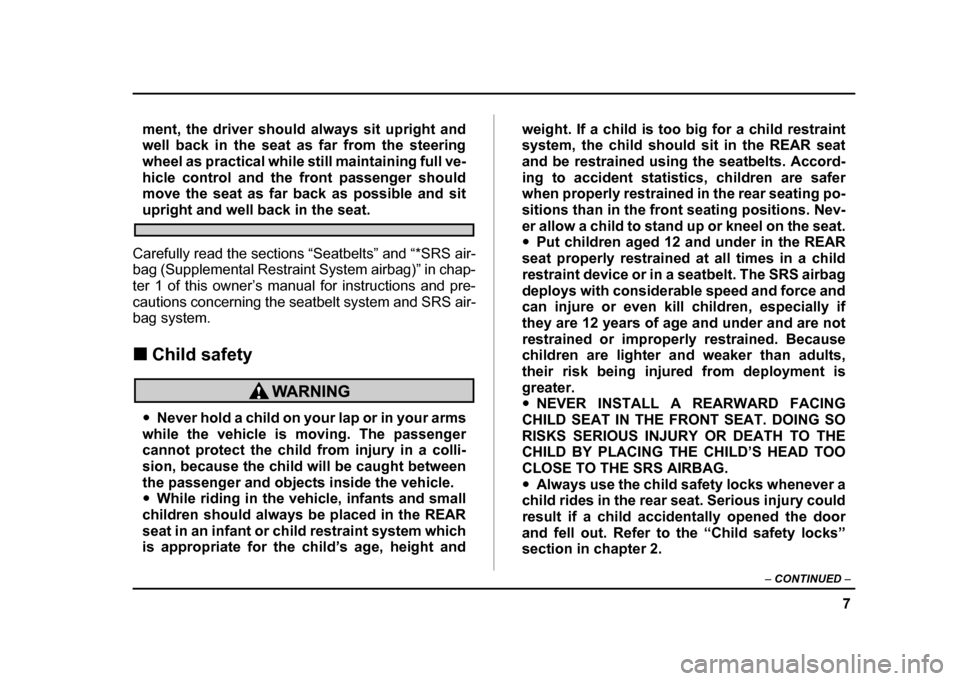
7
–
CONTINUED –
ment, the driver should always sit upright and
well back in the seat as far from the steering
wheel as practical while still maintaining full ve-
hicle control and the front passenger should
move the seat as far back as possible and sit
upright and well back in the seat.
Carefully read the sections “Seatbelts” and “*SRS air-
bag (Supplemental Restraint System airbag)” in chap-
ter 1 of this owner’s manual for instructions and pre-
cautions concerning the seatbelt system and SRS air-
bag system. ! Child safety
"Never hold a child on your lap or in your arms
while the vehicle is moving. The passenger
cannot protect the child from injury in a colli-
sion, because the child will be caught between
the passenger and objects inside the vehicle. " While riding in the vehicle, infants and small
children should always be placed in the REAR
seat in an infant or child restraint system which
is appropriate for the child’s age, height and weight. If a child is too big for a child restraint
system, the child should sit in the REAR seat
and be restrained using the seatbelts. Accord-
ing to accident statistics, children are safer
when properly restrained in the rear seating po-
sitions than in the front seating positions. Nev-
er allow a child to stand up or kneel on the seat. "
Put children aged 12 and under in the REAR
seat properly restrained at all times in a child
restraint device or in a seatbelt. The SRS airbag
deploys with considerable speed and force and
can injure or even kill children, especially if
they are 12 years of age and under and are not
restrained or improperly restrained. Because
children are lighter and weaker than adults,
their risk being injured from deployment is
greater. " NEVER INSTALL A REARWARD FACING
CHILD SEAT IN THE FRONT SEAT. DOING SO
RISKS SERIOUS INJURY OR DEATH TO THE
CHILD BY PLACING THE CHILD’S HEAD TOO
CLOSE TO THE SRS AIRBAG." Always use the child safety locks whenever a
child rides in the rear seat. Serious injury could
result if a child accidentally opened the door
and fell out. Refer to the “Child safety locks”
section in chapter 2.
Page 21 of 491
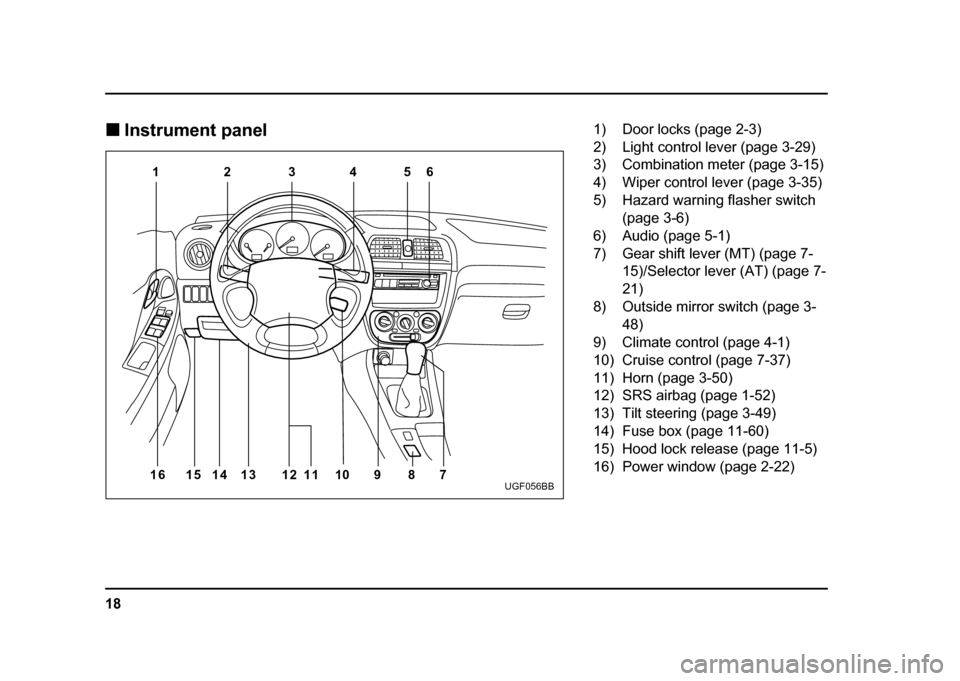
18
!
Instrument panel
12345 6
7
8
9
11
12
13
14
15
16 10
UGF056BB
1) Door locks (page 2-3)
2) Light control lever (page 3-29)
3) Combination meter (page 3-15)
4) Wiper control lever (page 3-35)
5) Hazard warning flasher switch
(page 3-6)
6) Audio (page 5-1)
7) Gear shift lever (MT) (page 7- 15)/Selector lever (AT) (page 7-
21)
8) Outside mirror switch (page 3-
48)
9) Climate control (page 4-1)
10) Cruise control (page 7-37)
11) Horn (page 3-50)
12) SRS airbag (page 1-52)
13) Tilt steering (page 3-49)
14) Fuse box (page 11-60)
15) Hood lock release (page 11-5)
16) Power window (page 2-22)
Page 43 of 491
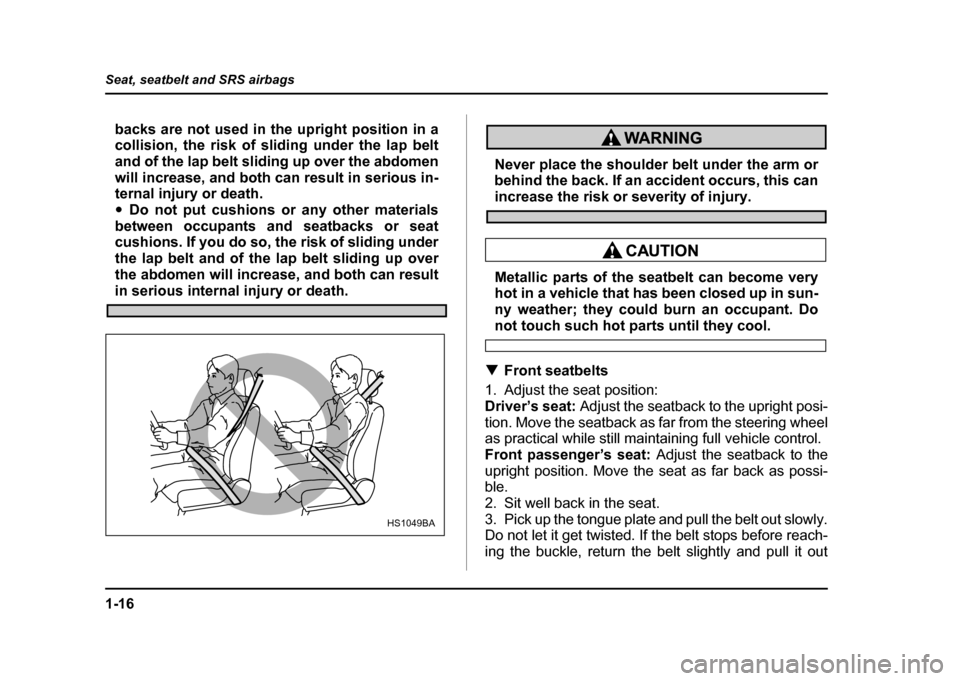
1-16
Seat, seatbelt and SRS airbags
backs are not used in the upright position in a
collision, the risk of sliding under the lap belt
and of the lap belt sliding up over the abdomen
will increase, and both can result in serious in-
ternal injury or death. "
Do not put cushions or any other materials
between occupants and seatbacks or seat
cushions. If you do so, the risk of sliding under
the lap belt and of the lap belt sliding up over
the abdomen will increase, and both can result
in serious internal injury or death.
Never place the shoulder belt under the arm or
behind the back. If an accident occurs, this can
increase the risk or severity of injury.
Metallic parts of the seatbelt can become very
hot in a vehicle that has been closed up in sun-
ny weather; they could burn an occupant. Do
not touch such hot parts until they cool.
! Front seatbelts
1. Adjust the seat position:
Driver’s seat: Adjust the seatback to the upright posi-
tion. Move the seatback as far from the steering wheel
as practical while still maintaining full vehicle control.
Front passenger’s seat: Adjust the seatback to the
upright position. Move the seat as far back as possi-
ble.
2. Sit well back in the seat.
3. Pick up the tongue plate and pull the belt out slowly.
Do not let it get twisted. If the belt stops before reach-
ing the buckle, return the belt slightly and pull it out
HS1049BA
Page 80 of 491
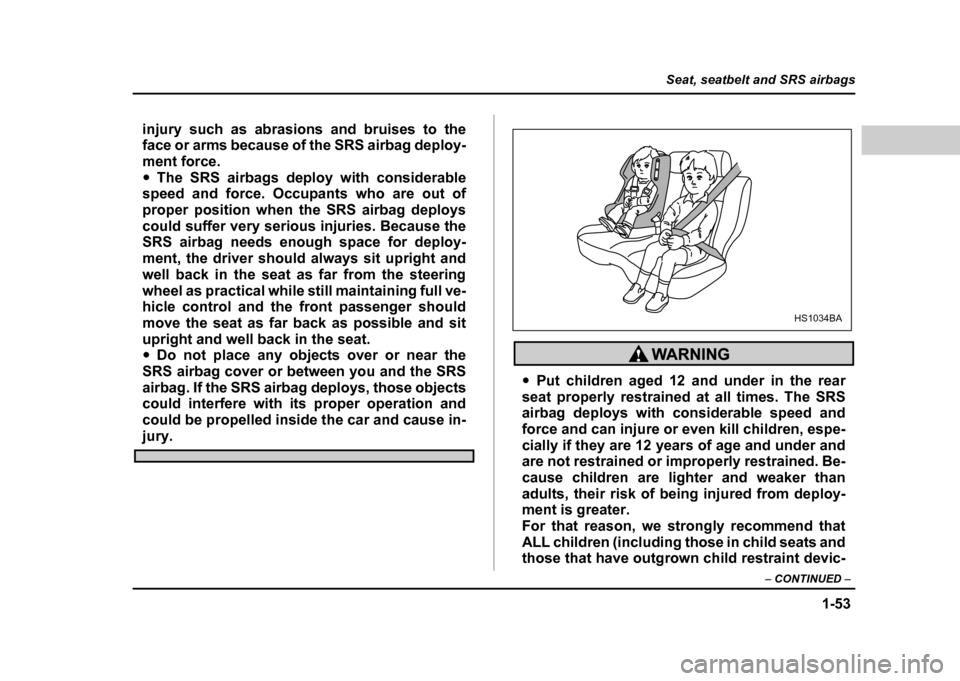
1-53
Seat, seatbelt and SRS airbags
– CONTINUED –
injury such as abrasions and bruises to the
face or arms because of the SRS airbag deploy-
ment force."The SRS airbags deploy with considerable
speed and force. Occupants who are out of
proper position when the SRS airbag deploys
could suffer very serious injuries. Because the
SRS airbag needs enough space for deploy-
ment, the driver should always sit upright and
well back in the seat as far from the steering
wheel as practical while still maintaining full ve-
hicle control and the front passenger should
move the seat as far back as possible and sit
upright and well back in the seat. " Do not place any objects over or near the
SRS airbag cover or between you and the SRS
airbag. If the SRS airbag deploys, those objects
could interfere with its proper operation and
could be propelled inside the car and cause in-
jury.
" Put children aged 12 and under in the rear
seat properly restrained at all times. The SRS
airbag deploys with considerable speed and
force and can injure or even kill children, espe-
cially if they are 12 years of age and under and
are not restrained or improperly restrained. Be-
cause children are lighter and weaker than
adults, their risk of being injured from deploy-
ment is greater.
For that reason, we strongly recommend that
ALL children (including those in child seats and
those that have outgrown child restraint devic-
HS1034BA
Page 83 of 491
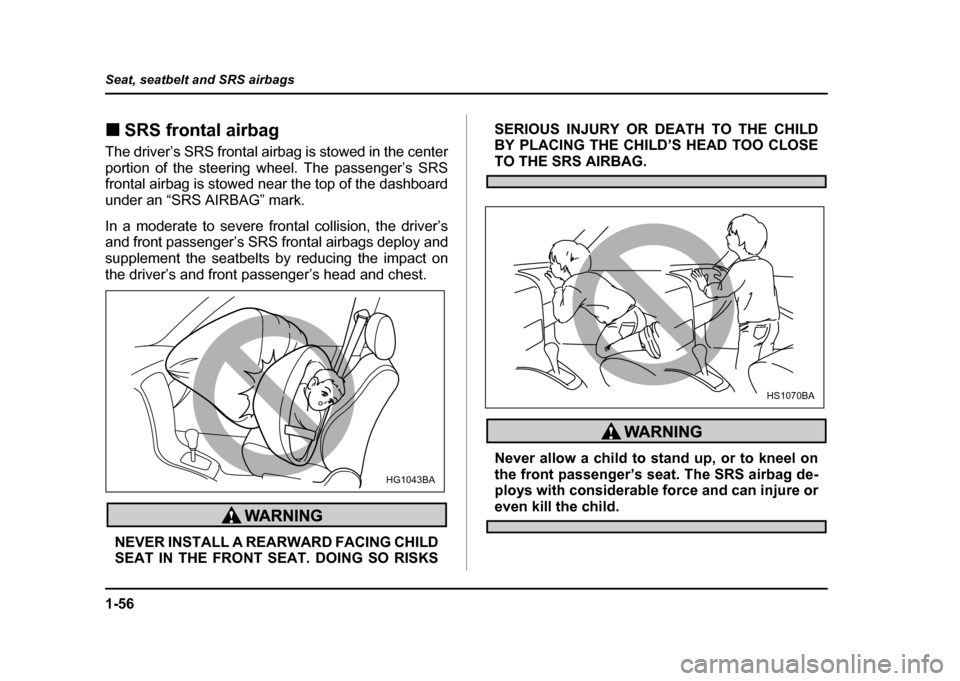
1-56
Seat, seatbelt and SRS airbags
!
SRS frontal airbag
The driver’s SRS frontal airbag is stowed in the center
portion of the steering wheel. The passenger’s SRS
frontal airbag is stowed near the top of the dashboard
under an “SRS AIRBAG” mark.
In a moderate to severe frontal collision, the driver’s
and front passenger’s SRS frontal airbags deploy and
supplement the seatbelts by reducing the impact on
the driver’s and front passenger’s head and chest.
NEVER INSTALL A REARWARD FACING CHILD
SEAT IN THE FRONT SEAT. DOING SO RISKS SERIOUS INJURY OR DEATH TO THE CHILD
BY PLACING THE CHILD’S HEAD TOO CLOSE
TO THE SRS AIRBAG.
Never allow a child to stand up, or to kneel on
the front passenger’s seat. The SRS airbag de-
ploys with considerable force and can injure or
even kill the child.
HG1043BA
HS1070BA
Page 84 of 491
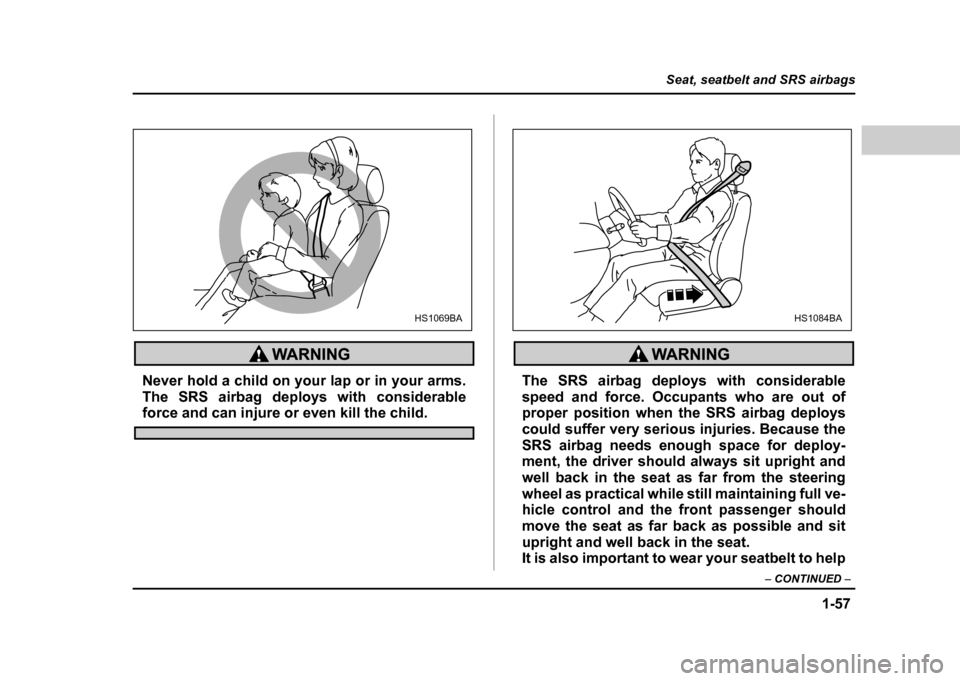
1-57
Seat, seatbelt and SRS airbags
– CONTINUED –
Never hold a child on your lap or in your arms.
The SRS airbag deploys with considerable
force and can injure or even kill the child.
The SRS airbag deploys with considerable
speed and force. Occupants who are out of
proper position when the SRS airbag deploys
could suffer very serious injuries. Because the
SRS airbag needs enough space for deploy-
ment, the driver should always sit upright and
well back in the seat as far from the steering
wheel as practical while still maintaining full ve-
hicle control and the front passenger should
move the seat as far back as possible and sit
upright and well back in the seat.
It is also important to wear your seatbelt to help
HS1069BAHS1084BA
Page 85 of 491
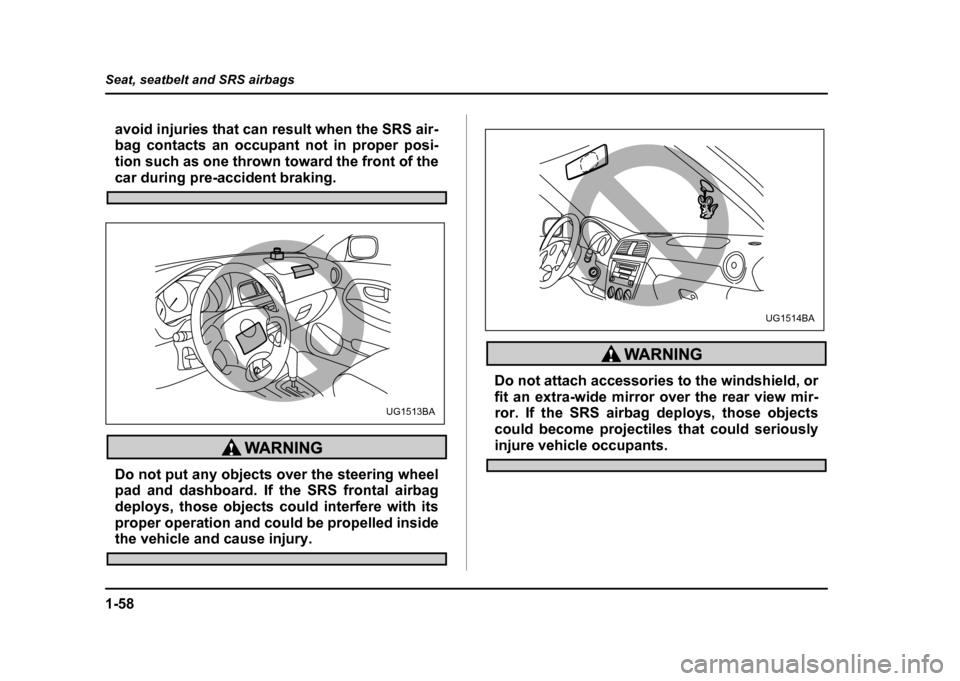
1-58
Seat, seatbelt and SRS airbags
avoid injuries that can result when the SRS air-
bag contacts an occupant not in proper posi-
tion such as one thrown toward the front of the
car during pre-accident braking.
Do not put any objects over the steering wheel
pad and dashboard. If the SRS frontal airbag
deploys, those objects could interfere with its
proper operation and could be propelled inside
the vehicle and cause injury.
Do not attach accessories to the windshield, or
fit an extra-wide mirror over the rear view mir-
ror. If the SRS airbag deploys, those objects
could become projectiles that could seriously
injure vehicle occupants.
UG1513BA
UG1514BA
Page 87 of 491
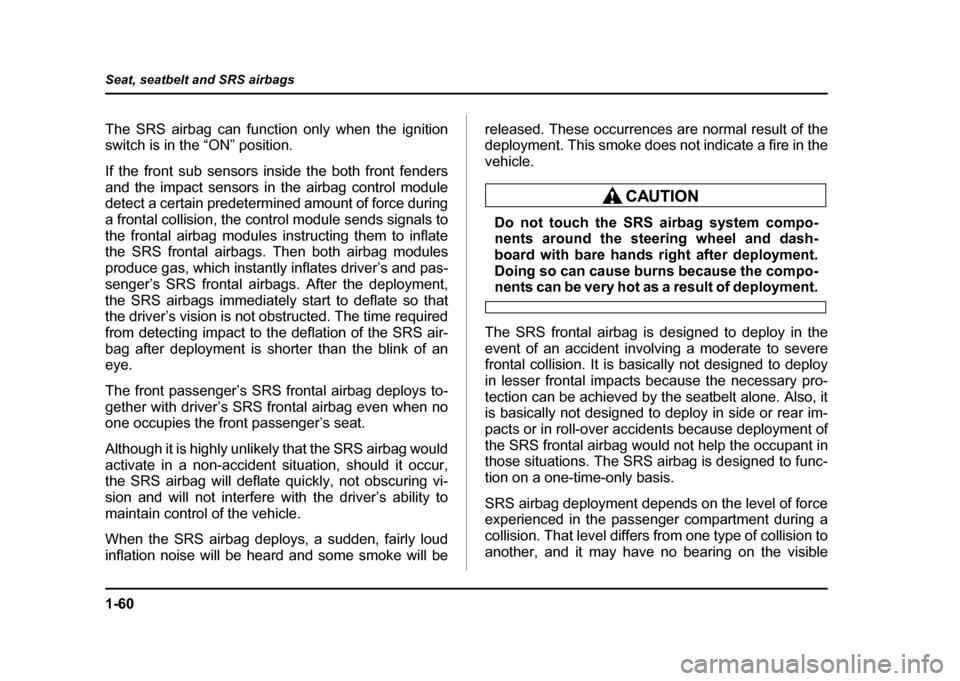
1-60
Seat, seatbelt and SRS airbags
The SRS airbag can function only when the ignition
switch is in the “ON” position.
If the front sub sensors inside the both front fenders
and the impact sensors in the airbag control module
detect a certain predetermined amount of force during
a frontal collision, the control module sends signals to
the frontal airbag modules instructing them to inflate
the SRS frontal airbags. Then both airbag modules
produce gas, which instantly inflates driver’s and pas-
senger’s SRS frontal airbags. After the deployment,
the SRS airbags immediately start to deflate so that
the driver’s vision is not obstructed. The time required
from detecting impact to the deflation of the SRS air-
bag after deployment is shorter than the blink of an eye.
The front passenger’s SRS frontal airbag deploys to-
gether with driver’s SRS frontal airbag even when no
one occupies the front passenger’s seat.
Although it is highly unlikely that the SRS airbag would
activate in a non-accident situation, should it occur,
the SRS airbag will deflate quickly, not obscuring vi-
sion and will not interfere with the driver’s ability to
maintain control of the vehicle.
When the SRS airbag deploys, a sudden, fairly loud
inflation noise will be heard and some smoke will be
released. These occurrences are normal result of the
deployment. This smoke does not indicate a fire in the vehicle.
Do not touch the SRS airbag system compo-
nents around the steering wheel and dash-
board with bare hands right after deployment.
Doing so can cause burns because the compo-
nents can be very hot as a result of deployment.
The SRS frontal airbag is designed to deploy in the
event of an accident involving a moderate to severe
frontal collision. It is basically not designed to deploy
in lesser frontal impacts because the necessary pro-
tection can be achieved by the seatbelt alone. Also, it
is basically not designed to deploy in side or rear im-
pacts or in roll-over accidents because deployment of
the SRS frontal airbag would not help the occupant in
those situations. The SRS airbag is designed to func-
tion on a one-time-only basis.
SRS airbag deployment depends on the level of force
experienced in the passenger compartment during a
collision. That level differs from one type of collision to
another, and it may have no bearing on the visible